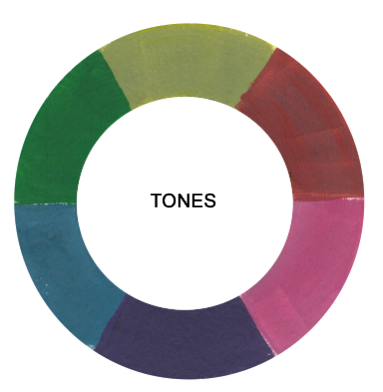A lot of us use the terms hue, tint, tone and shade when referring to color in art, but did you know each of these terms has a very specific meaning?
For a painter, knowing the difference between them all is important when communicating concepts in your painting. More importantly, you can use this knowledge for color mixing, helping you figure out how to mix just the right colors from your paints.
Hue:

Hue is a term that seems more complicated than it is. A hue is just a color. More specifically, a hue is any color on the color wheel. Hopefully, you’re familiar with the color wheel, but let’s go over it quickly if you need a refresher.
There are three primary colors, red, blue and yellow. Most of us also know that combining any two of those primary colors will give you one of the secondary colors: red and blue make violet, yellow and blue make green, and red and yellow make orange. A third set of colors, the tertiary colors, fill in the six gaps between the primary and secondary colors — red-orange, blue-green, red-violet and so on. Tertiary colors are pretty simple to figure out based on their names, so we won’t cover them here.
Colors on exact opposites of the color wheel are known as complementary colors. Mixing a color with its complement will give you a muddy brown.
You might have noticed that black and white are not colors on the color wheel, and thus are not hues. So where do they fit in when it comes to mixing colors?
Tints, tones, and shades are variations of the hues found on the basic color wheel when white, black or both are mixed in. To illustrate this, I painted a Tint, Tone and Shade color wheel using Liquitex Basics acrylic paint for each of the 6 primary and secondary colors.
At the center of the wheel, I have painted the six primary and secondary hues, just as in the color wheel shown above. Paints straight out of the tube vary by manufacturer and can skew towards cool (having qualities of the blue side of the color spectrum) or warm (having qualities of the red and yellow sides of the spectrum). Compare the hues below to the color wheel I noticed here that the Liquitex Basics “Primary Red” hue skews cool, as you’ll see.
Let’s break down the other rings of the wheel:
Tints

Tints are created when you add white to any hue on the color wheel. This will lighten and desaturate the hue, making it less intense. Tints are often referred to as pastel colors, and many feel they are calmer quieter colors. To make the tints below, I used equal parts white and the hue straight from the bottle. Again, the amounts needed will vary by manufacturer and paint variety, depending on the intensity of the pigment in a given paint.
Tones

Tones are created when you add both black and white to a hue. You could also say grey has been added. Depending on the proportions of black, white and the original hue used, tones can be darker or lighter than the original hue, and will also appear less saturated or intense than the original hue. Tones can reveal subtle and complex qualities in a hue or combination of hues, and are more true to the way we see colors in the real world.
Shades

Shades are created when only black is added to a hue. This results in a rich, often more intense and darker color. Because of the overpowering nature of many black pigments, adding black to a hue is a tricky and sometimes frustrating exercise when mixing paint. Many blacks will change the character of a hue even in small amounts, so they should be used sparingly. Alternatively, a hue can often be made darker by adding another dark hue rather than black. Testing different mixtures is the best approach.

This was very informative and helpful, thank you.